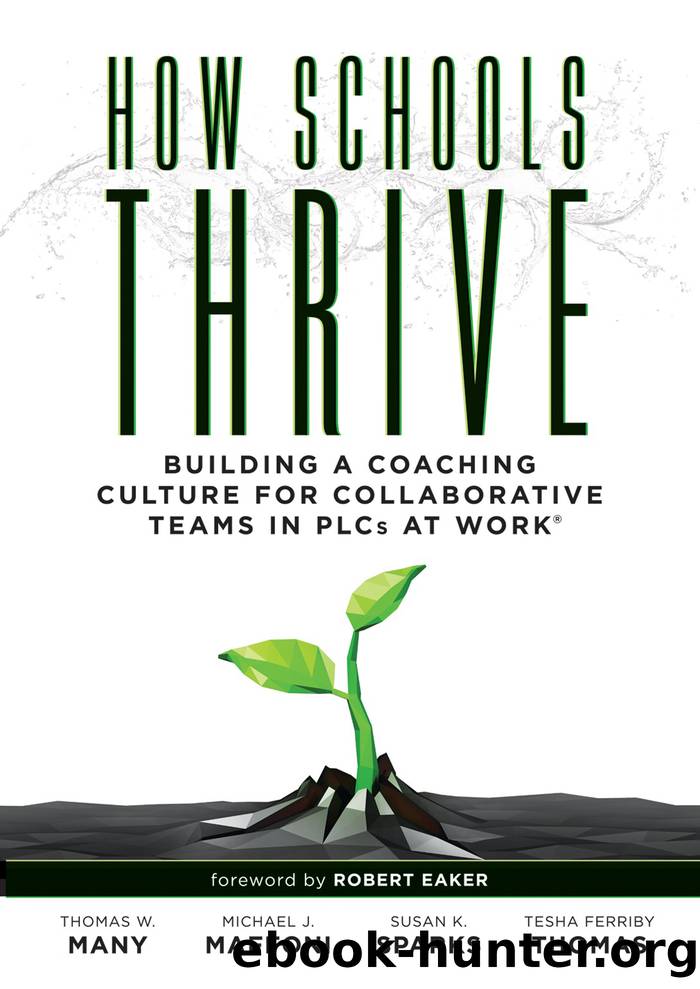How Schools Thrive by Many Thomas W.;Maffoni Michael J.;Sparks Susan K.;Thomas Tesha Ferriby;

Author:Many, Thomas W.;Maffoni, Michael J.;Sparks, Susan K.;Thomas, Tesha Ferriby;
Language: eng
Format: epub
Publisher: Solution Tree
Published: 2019-08-15T00:00:00+00:00
Connecting Learning to the Work
One of the best ways to promote an action orientation is to ask teams to produce products that are connected to the work. DuFour et al. (2016) describe this approach as âone of the purposeful steps leaders can take in creating a professional learning communityâ (p. 74). When teams create products such as rubrics, proficiency scales, common formative assessments, and graphic organizers, they deepen their understanding of the underlying foundation of concepts or practices. The simple act of producing a product has been known to propel teams into action.
During their early years of the PLC journey, the faculty and staff of Kildeer Countryside Community Consolidated School District 96 in Buffalo Grove, Illinois, were struggling to design a schoolwide and systematic intervention plan for their schools. Despite their best efforts, the administrative team could not reach consensus on what a plan for schoolwide and systematic interventions would look like. The team members agreed that if they could not write it down, the plan didnât really exist, and so after an especially spirited conversation, principals were asked to work with their teachers and other principals to create a parent brochure describing the plan and all the different resources that were available to students who were not yet proficient. The brochure was to include an explanation of the resources, actions, and commitments each level in the district was willing to make in order to ensure all students would learn.
A new sense of urgency was evident once teams were given the charge and a deadline for completion. Principals created an action research project and began to work with teachers on the brochure describing the intervention plans. They agreed to share draft copies, selected a protocol for receiving feedback, and committed to talking with students and parents before finalizing their brochures. Teacher teams worked together to read, research, and visit school sites that were successfully implementing a system of support. After several iterations, the district published three different brochures, one for each level, describing primary, elementary, and middle-level interventions and support.
The brochures were well received and represented a big improvement over existing practice; however, the action and support described were not perfect, and it wasnât long before they were revised. As teams implemented what they promised, they learned that some strategies worked better than others. New ideas quickly replaced the original ones, but they didnât view the changes as failures. Because the faculty had been engaged in working on the work, not reading about the work or talking about the work but actually doing the work from the start, there was a commitment to keep improving the intervention plans until schools got it right. The act of simply producing products had fostered the kind of action orientation that resulted in significant and lasting changes in practice.
This became a pattern and a way of working in the early days of PLC transformation in Kildeer District 96. The faculty and staff pushed through challenges with an action orientation. With hard work and persistence, in addition to the mindset of âprogress over perfectionâ (T.
Download
This site does not store any files on its server. We only index and link to content provided by other sites. Please contact the content providers to delete copyright contents if any and email us, we'll remove relevant links or contents immediately.
Competing on Culture by VanWagoner Randall;Sydow Debbie L.;Alfred Richard L.;(156)
Teaching Skills For Dummies by Sue Cowley(139)
The Art & Science of Web Design by Jeffery Veen(136)
Maker-Centered Learning by unknow(117)
People Skills by Thompson Neil(113)
Lorange P. Learning and Teaching Business...Lessons...2022 by Unknown(105)
Managing Unstoppable Learning by Hierck Tom;(103)
Motivating Defiant and Disruptive Students to Learn by Rich Korb(102)
The InterActive Classroom by Nash Ron;(98)
Forces of Influence by Ende Fred;Everette Meghan;(96)
Summarization in Any Subject by Wormeli Rick;Stafford Dedra;(95)
Teacher Mentoring and Induction by Portner Hal;(93)
Connecting Through Leadership by Kullar Jasmine K.;(93)
Academic Advising and the First College Year by Jenny R. Fox; Holly E. Martin(92)
Employee of the Month by Tracey Rogers(91)
What We Say and How We Say It Matter by Mike Anderson(87)
Reflective Practice in Action by Farrell Thomas S. C.;(87)
Leveraging Data for Student Success : Improving Education Through Data-Driven Decisions by Laura G. Knapp; Elizabeth Glennie; Karen J. Charles(87)
Teaching Behavior by Terrance M. Scott(83)
